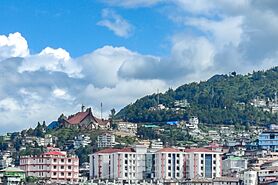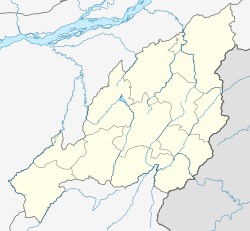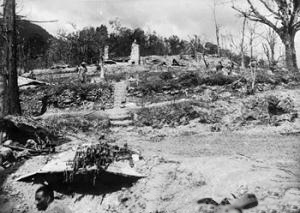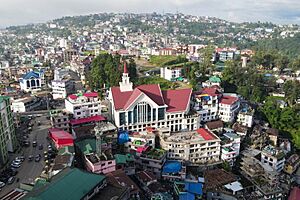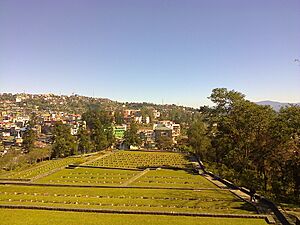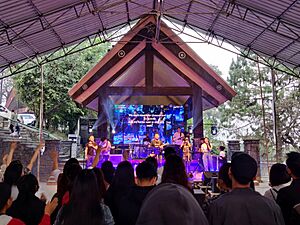Kohima facts for kids
Quick facts for kids
Kohima
Kewhira
|
|
|---|---|
| City of Kohima | |
|
From top (left to right):
Kohima skyline with Kohima Village on top; Kohima street; PHQ Junction; Aradurah Hill |
|
| Motto(s):
"Work is Pride"
|
|
| Country | |
| Region | Northeast India |
| State | |
| District | Kohima District |
| Divisions | 19 municipal wards |
| Government | |
| • Type | Municipality |
| • Body | Kohima Municipal Council |
| Area | |
| • Total | 20 km2 (8 sq mi) |
| Elevation | 1,444 m (4,738 ft) |
| Population
(2011)
|
|
| • Total | 115,283 |
| • Density | 5,800/km2 (15,000/sq mi) |
| Demonym(s) | Kohimian kewhi–mia |
| Languages | |
| • Official | English |
| • Major languages | Angami • Ao • Chakhesang • Lotha • Sümi |
| Time zone | UTC+5:30 (IST) |
| PIN |
797001
|
| Telephone code | 91 (0)370 |
| Vehicle registration | NL-01 |
| Sex ratio | 927 ♂/♀ |
| Climate | Temperate (Köppen) |
Kohima (![]() i/koʊˈhiːmə/; Angami Naga: Kewhira (IPA: [ˈkɛʍɪɻə])) is the capital of the North East Indian state of Nagaland. With a resident population of almost 100,000, it is the second largest city in the state. Kohima constitutes both a district and a municipality. The municipality covers 20 km2 (7.7 sq mi). The city lies on the foothills of Japfü section of the Barail Range located south of the District (25°40′N 94°07′E / 25.67°N 94.12°E) and has an average elevation of 1,261 m (4,137 ft).
i/koʊˈhiːmə/; Angami Naga: Kewhira (IPA: [ˈkɛʍɪɻə])) is the capital of the North East Indian state of Nagaland. With a resident population of almost 100,000, it is the second largest city in the state. Kohima constitutes both a district and a municipality. The municipality covers 20 km2 (7.7 sq mi). The city lies on the foothills of Japfü section of the Barail Range located south of the District (25°40′N 94°07′E / 25.67°N 94.12°E) and has an average elevation of 1,261 m (4,137 ft).
Originally known as Kewhira, Kohima's history goes back to a time when it was a village of the Angami Nagas. It became an urban centre in 1878 when the British Empire established its headquarters of the then Naga Hills District of Assam Province. It officially became the capital after the state of Nagaland was inaugurated in 1963. Kohima was the site of one of the bloodiest battles of World War II. The battle is often referred to as the Stalingrad of the East. In 2013, the British National Army Museum voted the Battle of Kohima to be Britain's Greatest Battle.
Contents
Etymology
Kohima was originally known as Kewhi–ra. People from different places and directions came in search of a place to settle down and formed a homogenous group that necessitated the establishment of a village. They named it Kewhira which is derived from the Angami word kephfükewhi which means to "meet and assemble together" and ra means "village" with its area jurisdiction. The people of Kewhira are called Kewhimia (mia means people) who are the indigenous inhabitants and hereditarily owned the land of Kewhira.
History
Medieval era
According to oral history, the historical founder of Kewhira Village was Tsiera (stone defender). The village is said to be more than 700 years old and is believed to be the second largest village in Asia. The village is divided into four large clans (thinuo): Tsütuonuomia, Lhisemia, Dapfhütsumia and Pfüchatsumia (T, L, D, and P Khel respectively).
Colonial era
The East India Company Administration started to expand into Kohima beginning the 1840s.
Battle of Kohima
In 1944 during the Second World War the Battle of Kohima along with the simultaneous Battle of Imphal was the turning point in the Burma Campaign. For the first time in South-East Asia, the Japanese lost the initiative to the Allies, which the Allies then retained until the end of the war. This hand-to-hand battle and slaughter prevented the Japanese Army from gaining a base from which they might have easily gone into the plains of India.
Kohima has a large cemetery known as the Kohima War Cemetery for the Allied war dead; it is maintained by the Commonwealth War Graves Commission. The cemetery lies on the slopes of Garrison Hill, in what was once the Deputy Commissioner's tennis court, which was the scene of intense fighting known as the Battle of the Tennis Court. The epitaph carved on the memorial of the 2nd British Division in the cemetery has become world-famous as the Kohima poem.
When You Go Home, Tell Them of Us and Say,
For Your Tomorrow, We Gave Our Today.
The verse is attributed to John Maxwell Edmonds (1875–1958), and is thought to have been inspired by the epitaph written by Simonides to honour the Greek who fell at the Battle of Thermopylae in 480 BC.
1963–present
When Nagaland became a full-fledged state on 1 December 1963, Kohima was named as the state capital.
2017 Nagaland protests
On 2 February 2017, the office building of the Kohima Municipal Council was burned down by a mob as part of the boycott of the Civic Elections. The fire significantly damaged adjoining government and private buildings. On 19 February, in response against the backdrop of widespread protests and civil unrest in the state, T. R. Zeliang announced his resignation as the Chief Minister of Nagaland.
2023 Kohima fire
On 27 February 2023, a massive fire broke in Mao Market and NN Market, one of the biggest commercial areas in Kohima, causing complete damage to the markets.
Geography
Topography
Kohima is located at 25°67' North, 94°10' East, in the southern part of Nagaland. It lies north of the Japfü–Barail intersection with Pulie Badze to the southwest overlooking the city.
Climate
The city experiences a subtropical highland climate (Köppen: Cwb), with greater contrast between summer and winter than in other continents due to the monsoons but mild temperatures even for latitude and altitude. The months of June to September concentrate much of the precipitation.
| Climate data for Kohima (1961–1990, extremes 1952–2012) | |||||||||||||
|---|---|---|---|---|---|---|---|---|---|---|---|---|---|
| Month | Jan | Feb | Mar | Apr | May | Jun | Jul | Aug | Sep | Oct | Nov | Dec | Year |
| Record high °C (°F) | 24.5 (76.1) |
25.0 (77.0) |
29.1 (84.4) |
32.2 (90.0) |
33.9 (93.0) |
30.5 (86.9) |
33.1 (91.6) |
31.1 (88.0) |
31.0 (87.8) |
31.5 (88.7) |
29.5 (85.1) |
26.0 (78.8) |
33.9 (93.0) |
| Mean daily maximum °C (°F) | 15.5 (59.9) |
17.7 (63.9) |
21.7 (71.1) |
23.8 (74.8) |
23.8 (74.8) |
24.7 (76.5) |
25.1 (77.2) |
25.3 (77.5) |
24.8 (76.6) |
23.7 (74.7) |
20.7 (69.3) |
17.9 (64.2) |
22.1 (71.8) |
| Daily mean °C (°F) | 11.6 (52.9) |
13.4 (56.1) |
17.3 (63.1) |
19.6 (67.3) |
20.4 (68.7) |
21.6 (70.9) |
21.5 (70.7) |
21.6 (70.9) |
21.3 (70.3) |
20.1 (68.2) |
16.6 (61.9) |
13.4 (56.1) |
18.2 (64.8) |
| Mean daily minimum °C (°F) | 8.0 (46.4) |
9.3 (48.7) |
11.2 (52.2) |
15.0 (59.0) |
16.6 (61.9) |
17.8 (64.0) |
18.7 (65.7) |
18.9 (66.0) |
17.9 (64.2) |
16.7 (62.1) |
13.1 (55.6) |
9.2 (48.6) |
14.5 (58.1) |
| Record low °C (°F) | 0.6 (33.1) |
2.3 (36.1) |
4.0 (39.2) |
5.0 (41.0) |
8.3 (46.9) |
9.4 (48.9) |
7.8 (46.0) |
8.3 (46.9) |
8.9 (48.0) |
5.0 (41.0) |
3.1 (37.6) |
2.2 (36.0) |
0.6 (33.1) |
| Average rainfall mm (inches) | 9.6 (0.38) |
24.0 (0.94) |
48.4 (1.91) |
92.2 (3.63) |
133.4 (5.25) |
323.6 (12.74) |
363.3 (14.30) |
360.7 (14.20) |
228.6 (9.00) |
134.8 (5.31) |
32.5 (1.28) |
5.8 (0.23) |
1,756.9 (69.17) |
| Average rainy days | 1.2 | 2.5 | 4.5 | 8.3 | 12.2 | 19.0 | 22.1 | 19.3 | 16.4 | 9.1 | 2.3 | 0.6 | 117.5 |
| Average relative humidity (%) | 74 | 67 | 65 | 70 | 77 | 85 | 88 | 88 | 86 | 83 | 76 | 71 | 78 |
| Source: India Meteorological Department | |||||||||||||
Kohima has been ranked 36th best “National Clean Air City” under (Category 3 population under 3 lakhs cities) in India.
Environment
Water supply and availability
Most Wards in Kohima experiences severe water shortages during the dry seasons. The current water resources from the reservoirs of Zarü River and the streams from the slopes of Pulie Badze do not fulfill the needs of the rapidly growing population of Kohima. With the augmentation of the Zarü River project and several other upcoming water projects to be supplied from Dzüko Valley and others. The water supply is expected to cover more wards.
Administration
The Kohima Municipal Council (KMC) was established in 2005 under India's Constitution (Seventy-Fourth Amendment) Act, 1992. It has waste management, drainage and trade licensing and other responsibilities.
Other departments of the state government, which sit in Kohima, also have a role in the administration of Kohima. The "City Development Plan" for the town, for example, was written by state Urban Development Department.
Wards
Kohima is divided into nineteen sectors with a total of thirty-three administrative wards under the authority of the Kohima Municipal Council, covering an area of about 35 km2 (14 sq mi). Each ward has its own council government and handles many of the functions that are handled by city governments in other jurisdictions.
- Agri Farm Ward
- Bayavü Hill Ward
- Daklane Ward
- D. Block Ward
- Dzüvürü Ward
- Electrical Ward
- Forest Ward
- Jail Ward
- Kenuozou Hill Ward
- Keziekie Ward
- Kitsübozou Ward
- Lerie Ward
- Lower Mediezie Ward
- Lower Chandmari Ward
- Lower Police Reserve Hill Ward
- Lower PWD Ward
- Merhülietsa Ward
- Middle PWD Ward
- Midland Ward
- Naga Bazaar Ward
- Naga Hospital Ward
- New Market Ward
- New Ministers' Hill Ward
- New Reserve Ward
- Old Ministers' Hill Ward
- Peraciezie Ward
- Police Reserve Hill Ward
- Sepfüzou Ward
- Thegabakha Ward
- Tsiepfü Tsiepfhe Ward
- Upper Mediezie Ward
- Upper Chandmari Ward
- Upper PWD Ward
Public safety
Police and law enforcement
The Kohima Police of the Nagaland Police is the police force responsible for maintaining security, law and order in the Kohima Metropolitan Area. It is headed by a Superintendent of Police (SP). Kevithuto Sophie is the current SP of Kohima.
In 2020, the Kohima North Police Station became the first police station and a government facility in the entire North Eastern Region of India to receive the International Organization for Standardization (ISO) 9001 Certification for quality management system.
Demographics
Census data
| Historical population | ||
|---|---|---|
| Year | Pop. | ±% |
| 1910 | 2,423 | — |
| 1920 | 2,790 | +15.1% |
| 1930 | 2,759 | −1.1% |
| 1940 | 3,507 | +27.1% |
| 1950 | 4,125 | +17.6% |
| 1960 | 7,246 | +75.7% |
| 1970 | 21,545 | +197.3% |
| 1980 | 34,340 | +59.4% |
| 1990 | 51,418 | +49.7% |
| 2000 | 77,030 | +49.8% |
| 2010 | 99,039 | +28.6% |
| Kohima Decadal Growth: | ||
As of 2011, Kohima had a population of 99,039 of which males and females were 51,626 and 47,413 respectively. Kohima has an average literacy rate of 90.76%, higher than the national average of 76.55%.
Religion
The major religion in Kohima is Christianity which is practised by 80.22% of the population. Other religions includes Hinduism (16.09%), Islam (3.06%) and Buddhism (0.45%).
Economy
Tourism
Tourism plays an important role in the city's economy. The number of tourists visiting Kohima has been increasing significantly each year.
Cityscape
Historical sites
- Kohima War Cemetery
Kohima War Cemetery is a memorial dedicated to soldiers of the 2nd British Division of the Allied Forces who died in the Second World War at Kohima in April 1944. There are 1,420 Commonwealth burials of the Second World War at this cemetery.
Parks
- Sakhrie Park
Sakhrie Park is a recreational park located at Middle Tsiepfü Tsiepfhe Ward (Middle AG) located between the Asian Highway 1 and the Tsiepfü Tsiepfhe Road (AG).
- Sokhriezie Park
Sokhriezie Park is a centrally located lake that sits below the PHQ Junction.
- Kohima Botanical Garden
Kohima Botanical Garden is located at New Ministers' Hill Ward and is looked after by the Nagaland Forest Department.
Culture
Cultural centers
The Kohima Capital Cultural Center is a cultural center which has a multipurpose hall that provides various facilities for its citizens. The Regional Centre of Excellence for Music & Performing Arts (RCEMPA) is a contemporary arts and music centre located in Jotsoma, about 6 km (3.7 mi) west of the city centre.
Events and Festivals
- NAJ Cosfest
The NAJ Cosfest is an Otaku-based cosplay festival held every year in the month of July. The annual event was started in 2013. The cosfest is one of the biggest cosplay festivals in North East India.
- Hornbill Festival
The Hornbill Festival is the biggest annual festival in North East India. The festival is held every year from 1 to 10 December with the purpose to promote the richness of the Naga heritage and traditions. The main venue is located at the Kisama Heritage Village, located 12 km (7.5 mi) south of the city centre.
Fashion
The inhabitants of Kohima have been historically characterized as "fashion-conscious". Numerous fashion stores are located across the city and a number of fashion related events are held annually. The southern wards starting from Main Town and beyond are the most fashionable areas of Kohima.
Museums
The Nagaland State Museum is located in Bayavü Hill and displays a comprehensive collection of artefacts including ancient sculptures, traditional dresses, inscriptions of the Naga people.
Religious sites
The Kohima Jain Temple, the oldest Jain temple in North East India was established in 1920.
Media
The most widely circulated newspapers in Kohima are The Morung Express, Nagaland Post, Eastern Mirror, Nagaland Page and the local newspaper Capi. The city was also home to the now defunct Kewhira Dielie, the first modern newspaper published from Nagaland.
State-owned All India Radio has a local station in Kohima, which transmits various programs of mass interest like AIR FM Tragopan, etc.
Transportation
The major public transportation in Kohima are buses and taxis.
Rail
Kohima is not connected with the rail network. The nearest railway stations are the Chümoukedima Shokhüvi Railway Station and the Dimapur Railway Station. An extension of the railway line from Dimapur to Kohima was proposed and surveyed in 2009. Due to a dispute over land acquisition the track was resurveyed and an alternative alignment was proposed in 2013 and is expected to be completed by 2026.
Cycling
Regardless of its hilly terrain, cycling has become an increasingly popular way to get in and around Kohima. A bicycle-sharing system was launched in September 2020.
Education
Sports
Wrestling
The Naga wrestling enjoys widespread popularity in Kohima with people from all over Nagaland coming to witness the Naga Wrestling Championship held every two years at the Khuochiezhie Local Ground located in the heart of Kohima. The first Naga Wrestling Tournament was held in Kohima in 1971.
Notable people
See also
 In Spanish: Kohima para niños
In Spanish: Kohima para niños





